Nearly 500,000 people marched on Washington for women's rights - here's what it was like to join the crowd
Train tickets costed an arm and a leg, so my wife, daughter, and I drove to Washington DC on Friday, January 20. We somehow avoided gridlock traffic on account of President Donald Trump's inauguration.

Hotels were also expensive, so we stayed with a relative in Arlington, Virginia — just west of the Potomac River. As we settled in, we watched coverage of the inauguration, parade, and related events.
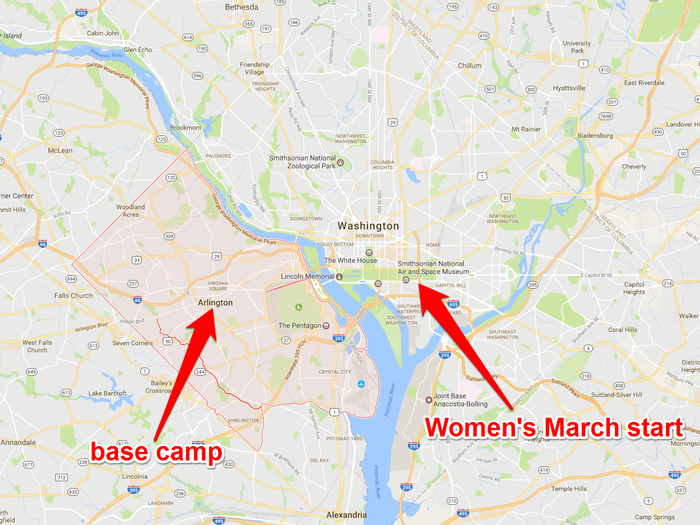
It was more than a little concerning for us to see reports of protesters throwing rocks at police ...
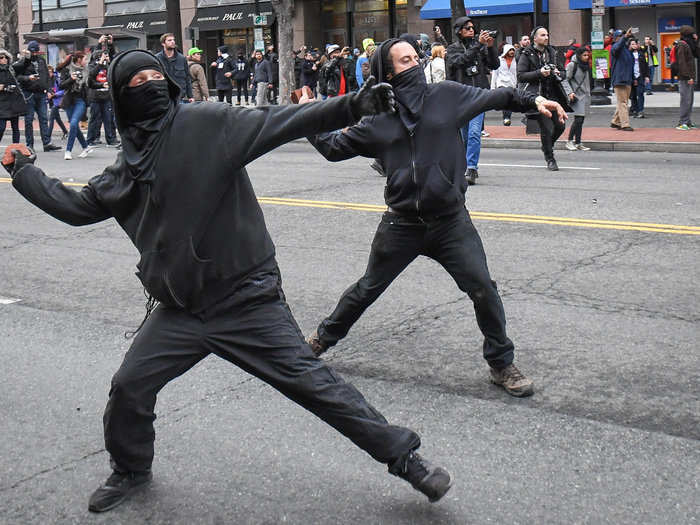
Source: Reuters/Business Insider
... and setting fires on the streets. But these acts were isolated, and we expected a family-friendly gathering of roughly 200,000 people (the number Women's March organizers expected) to buffer against such actions on Saturday, January 21.
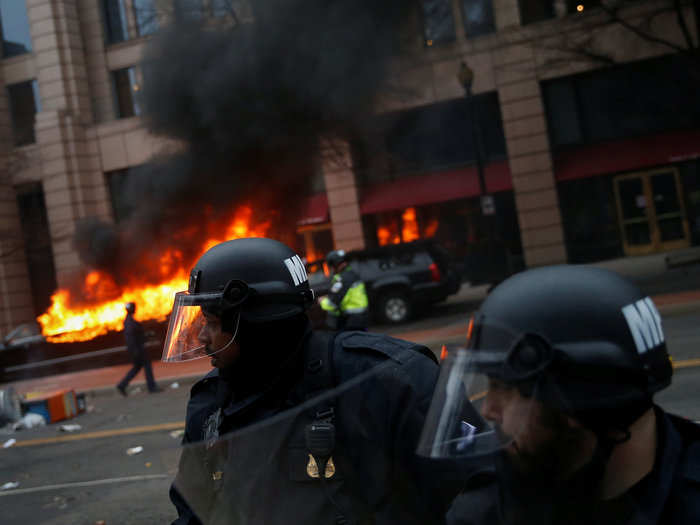
Just to be safe, I added some last-minute items to my reporting kit — mainly in case I needed to escape from a cloud of tear gas or help anyone who was injured.
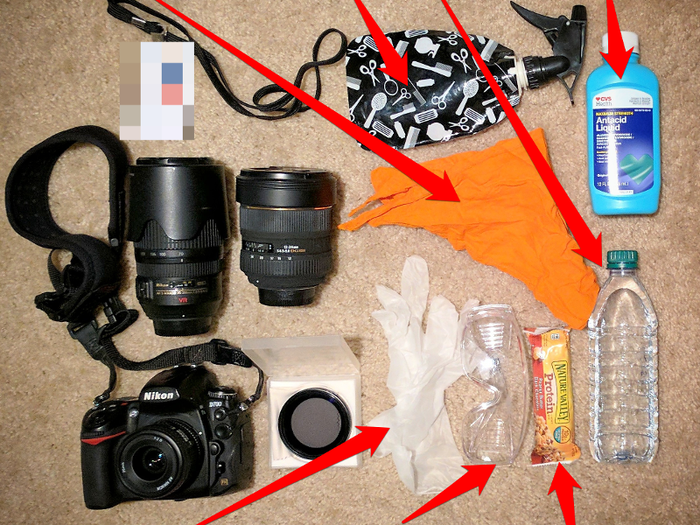
I'm not a doctor, so this isn't medical advice. That said, I'd read that a 50/50 mixture of water and certain liquid antacids is effective in reducing the pain caused by capsaicin — the active ingredient in teargas (and hot peppers).
The gloves were to cover my hands from capsaicin exposure, or help treat myself or someone else with first-aid. The goggles and handkerchief were to protect my face from debris and teargas.
Luckily, I didn't need any of those supplies. The march was very peaceful, and not one person was arrested.
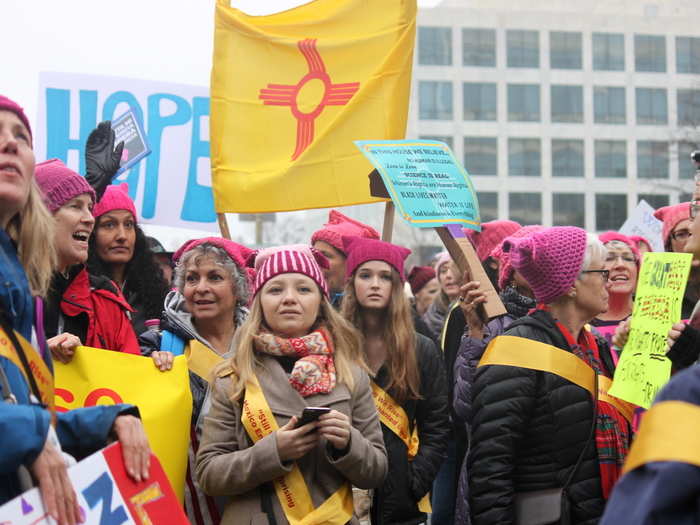
Source: Associated Press
A rally was scheduled to start at 10 a.m. ET, and the roughly 2-mile-long march was supposed to follow at 1:15 p.m. ET. I left a little after 9 a.m. ET hoping to make both.
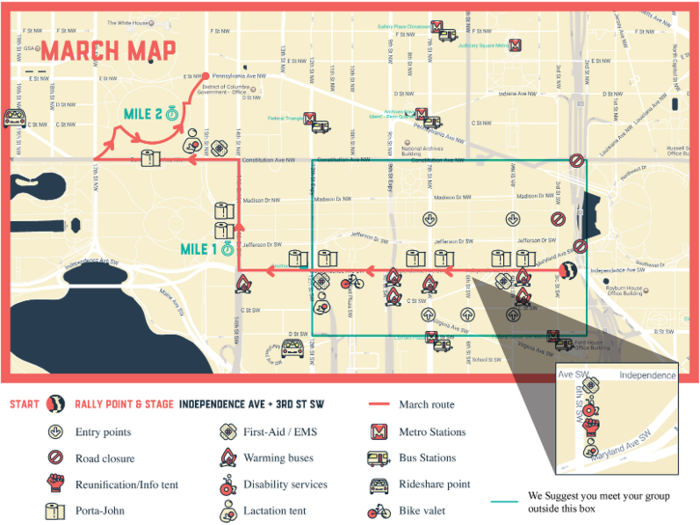
But when I got to the Metro stop in Arlington, located some 5 miles away from the rally, the scene did not look encouraging.
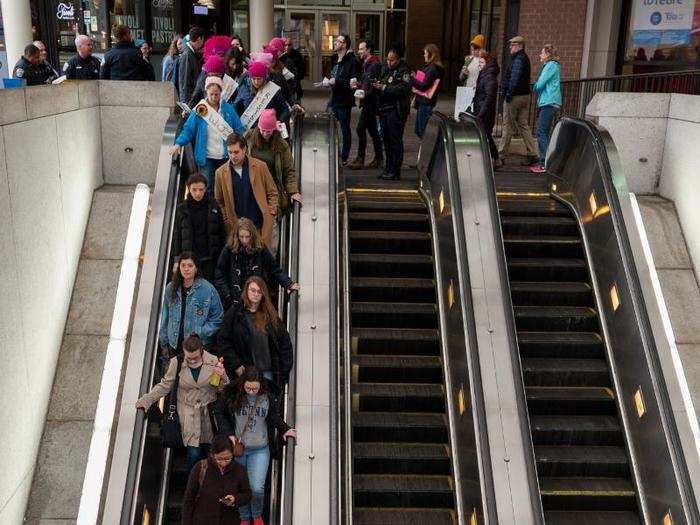
The line to board the subway stretched from the train platform all the way up the escalator.
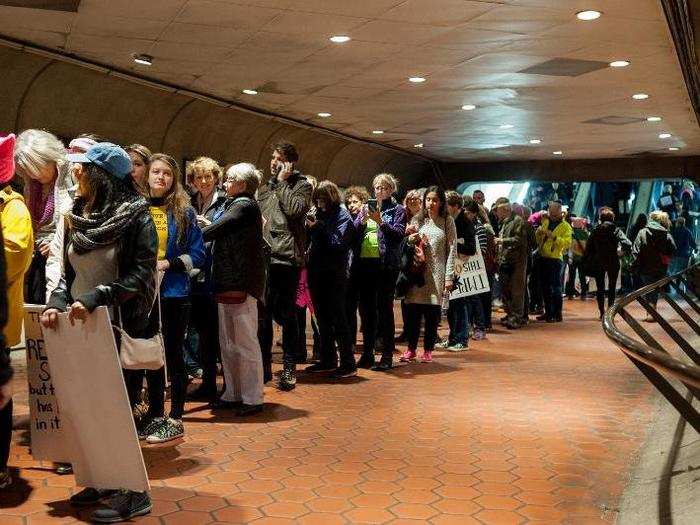
After about 45 minutes of inching forward, I managed to squeeze through a turnstile and board a train going the opposite direction.
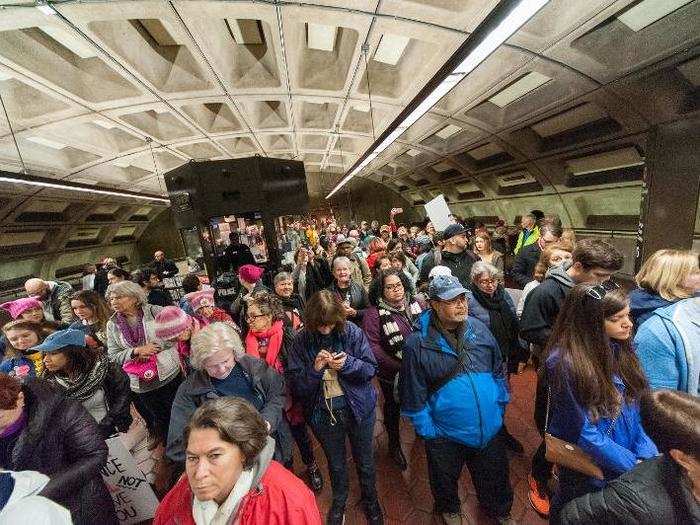
I reasoned that going a stop or two farther out would make it easier to get on a DC-bound train. It was hard to know if it saved me any time, but it felt good to be moving.
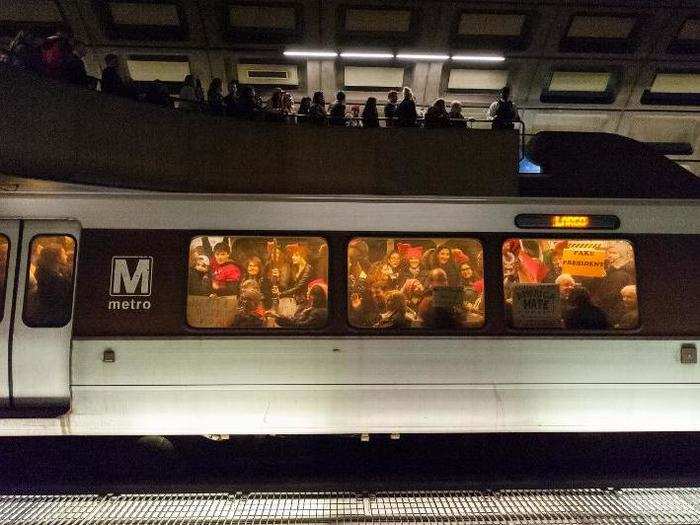
I saw countless marchers wearing pink "pussy hats", like these two friends I interviewed on the Metro. They wore them in solidarity and protest of President Trump's descriptions of sexual assault and demeaning views of women from 2005.
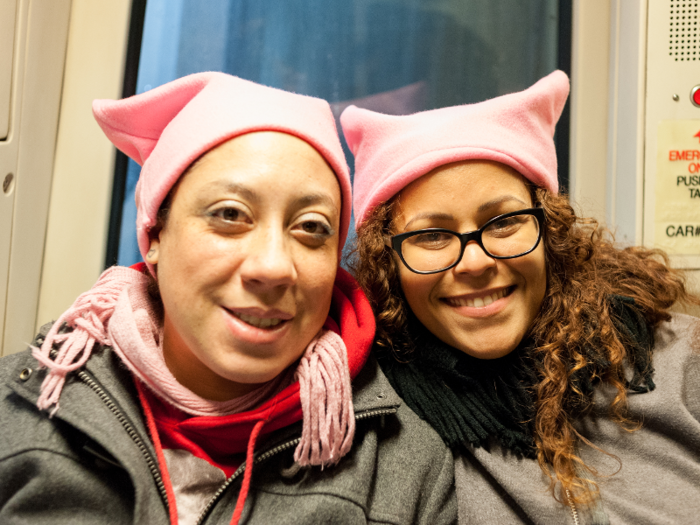
"I think we deserve rights like everybody else, whether it's for me, for my friend, for my kids, for my son, for you, for everybody. [...] This is a mark of history and I'm glad to be a part of it." —Tarina Ewell, a military veteran of two wars in Iraq and a single mother of three children
"I went over here with a vision that we are all created equal. Yes, there are differences of opinions, but we need to respect each other's opinions and have a forum where we can dialog, and come together, without disrespecting any other people. We can talk and we can blog, we can [use] social media about things, but this is actual engagement." —Eunce Ilarraza, peer counselor to veterans with mental health issues, from Richmond, Virginia
Source: Business Insider
The Washington Post exposed Trump's views in October 2016, publishing off-camera audio taped during a 2005 Access Hollywood interview. Trump said of women that, as a celebrity, anyone can "Grab 'em by the p---y. You can do anything."
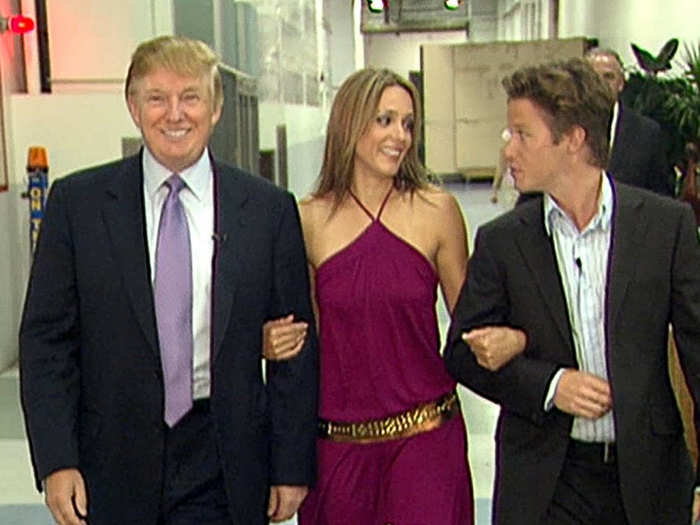
Source: The Washington Post, USA Today
Trump apologized for his remarks shortly after the story broke, but it was just one of many lewd and demeaning things he's said about women over the decades. Many of the signs at the march were cutting rebukes of the Trump's words.
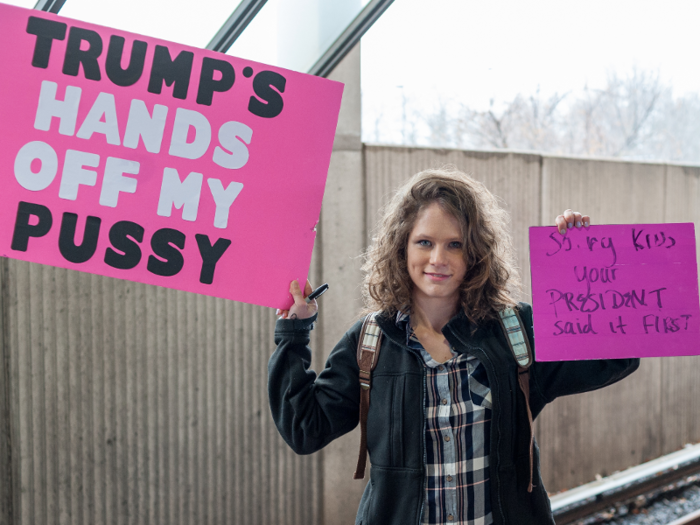
It was easy to board a train farther out, but the cars almost instantly filled up as they crawled toward the city center.

I spent my time on the train interviewing people nearby about their reasons for marching. This mother and daughter (and father and brother, not pictured) came from Cary, North Carolina.
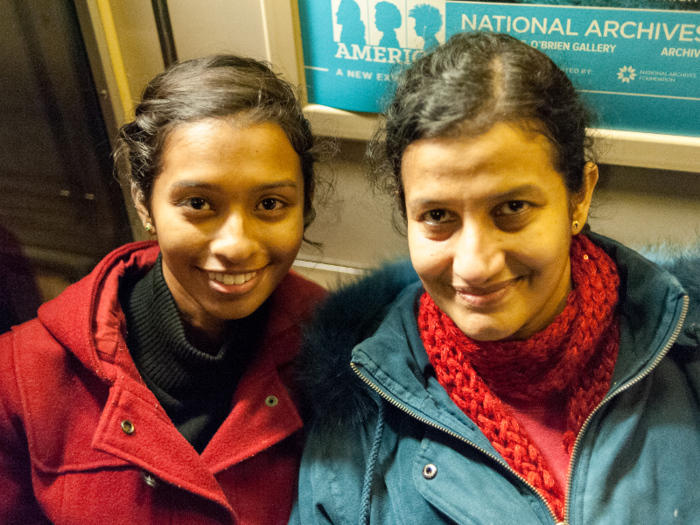
"We want to be a part of something where we can all voice our dissatisfaction with the current political process, and not just about the election of President Trump, but also a lot of the proposed laws that congressmen are putting into action. I think this march is a really good way to show our dissatisfaction, and show how widespread it is. [...] I think that'll make lawmakers and President Trump, it will make them be wary of their actions. [...] It's a very active decision being a person of color and coming to a march like this. [...] There's a lot of people of color concerned that their narrative is being lost, especially when you look at it historically, because this type of protest and this type of standing up really has such a strong root in the Civil Rights [movement] of the '60s. [...] For me the decision to come was pretty easy and it wasn't colored by that, because I still feel like any number of people, when we unite and stand up, that's a step in the right direction." —Sruti Pisharody, a 22-year-old medical student
"I'm walking for women's rights. I'm walking for any injustice toward any race, any religion. I want America to be as great as it was all these years. I do not want it to change — definitely not for the worse. [...] I think it has been a divisive election, and I think that our president has brought out the worst in people. So I would like us to be united once again, to be the great country that I believe we were." —Sruti Pisharody, a physician at Duke University
These two sisters brought brought their daughters from far-flung cities to join the march.
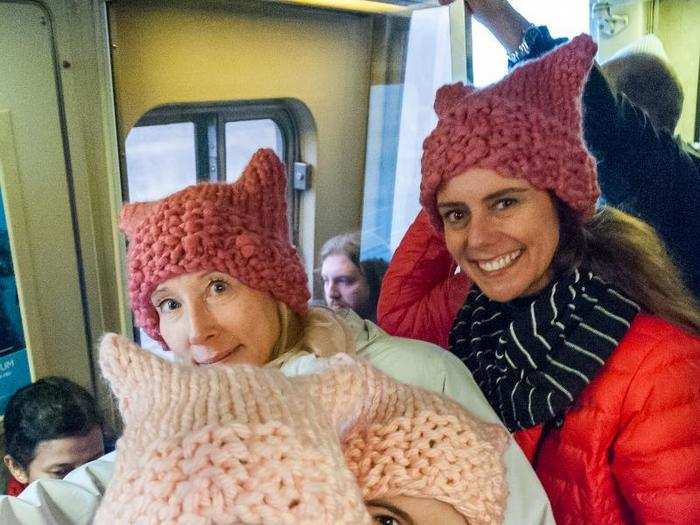
"I decided a couple of days after the election that I wanted to make sure that all rights were being observed, and it was important to me to do something. And when I found out about this march, I said I had to be here." —Jennifer Rorke, Minneapolis, Minnesota
"Rights matter." —Fanny Rourke, Minneapolis, Minnesota
"I'm marching for my daughters, for people's rights, for making sure that everybody still has a voice. [...] That if [my daughters] are not happy with the result of something, they can stand up and protest. That's the beauty of this country." —Ellen Firek, Los Angeles, California
Many people decided to come just a day or two beforehand. This couple temporarily left their restaurant behind and drove more than 7 hours to march.
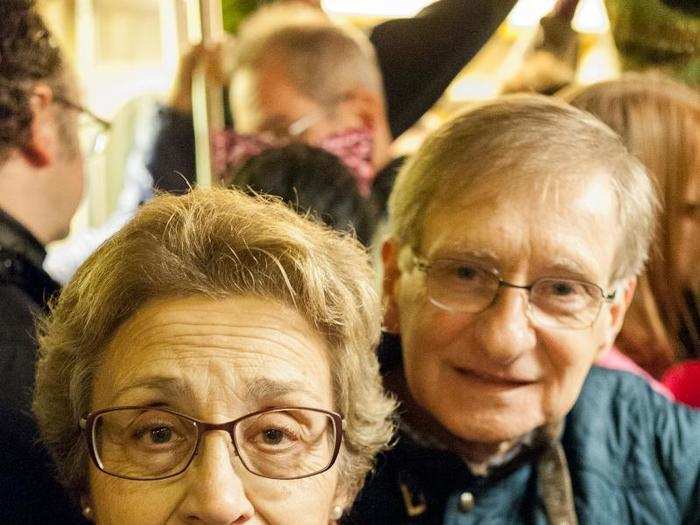
"I'm here as a person who's lived through Nixon, a very ugly time in our history, and I feel this is probably, in many respects, more difficult. There's so much at stake here. I've never imagined a person so unqualified could become my president. [...] [W]hat I see here is so much love and frustration that I'm hoping, when we get back to our communities, we can do something to keep this movement going, this making people aware that they can have an impact. I think if we all go into our communities and meet as groups, we can do something to keep him on track. Because left alone, I have no idea where this is gonna go." —Pat Bryant, a 70-year-old restaurant owner who came from Rochester, New York
Everyone was thrilled to get off the jam-packed Metro cars, which carried more than a million people that day — twice as many as the day of Trump's inauguration.
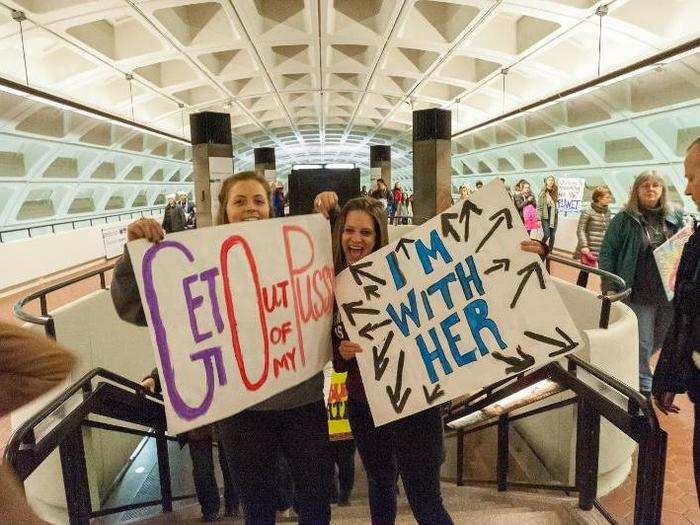
Source: The Washington Post
In total, it me took about 2 hours to go a few miles — a commute that takes 25 to 30 minutes on a typical Saturday morning, according to Google maps. I probably should have walked.
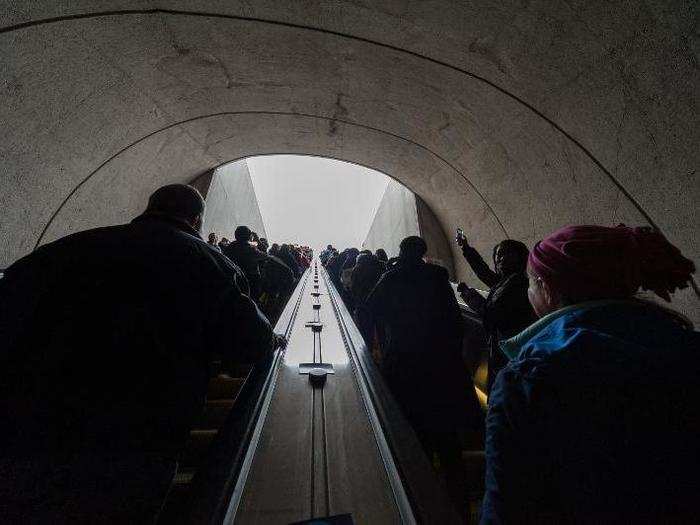
As I emerged above-ground near the Capitol building, loud cheers — and colorful signs — greeted everyone.
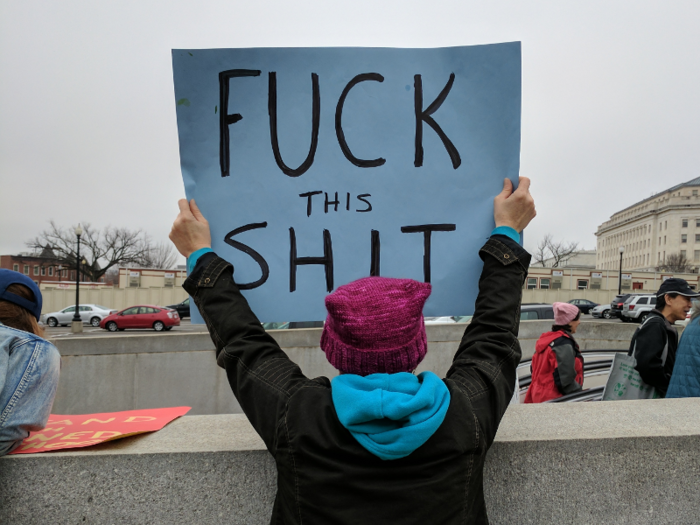
While walking toward the rally, I spoke to more people who were willing, and their causes were as diverse as their backgrounds. Some marched for civil rights and equality.
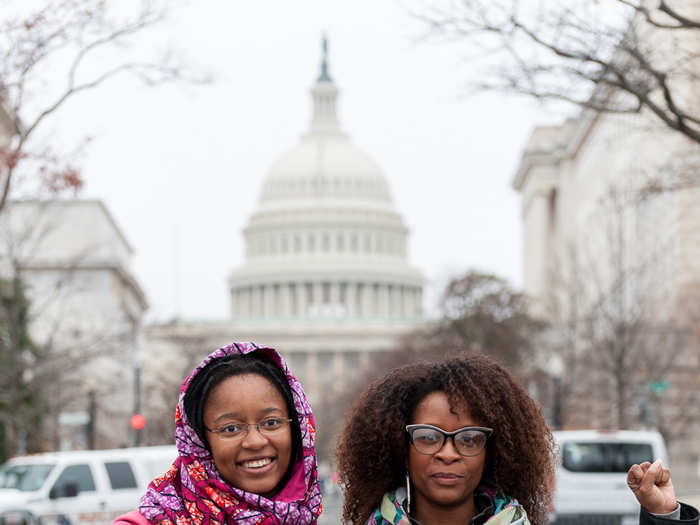
"I came to the march because this election has completely thrown me for a loop — that Americans would be so disheartened by the last administration that they would ignore women's rights and equal rights for humans in general. [...] If I stayed home, then my voice wouldn't be heard. And I'm a woman, just like any other woman, and my rights were and always have been at stake. So I feel like this particular march, no matter where it began, no matter where it is now, if you don't include yourself, you're silenced." —Carmella Long, a social worker in the Washington DC region
"I am marching in solidarity with all the African Americans, and females, and LGBTQ people, and all the minorities that are threatened by this new presidency. [...] As an American, I'm going to continue to fight for true American values. I feel like we, as the next generation... I have to include myself in these trying times." —Dejia Long Hillie, 18 years old
Others marched for unions, citing their ability to help close gender and racial gaps in pay and treatment at work.
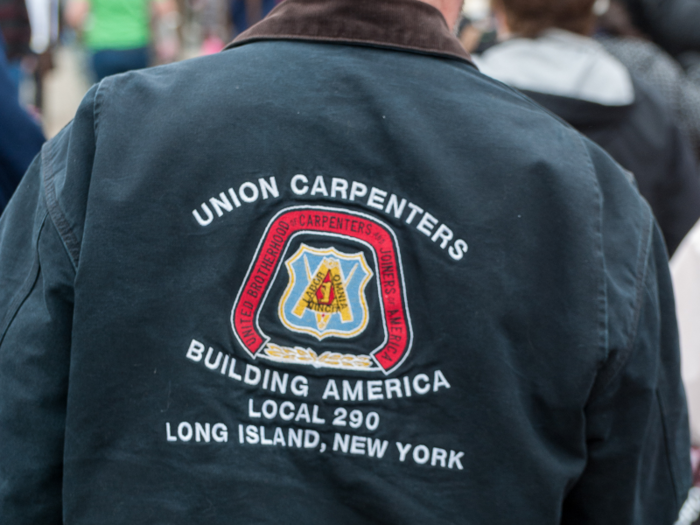
And a large contingent of women came out to support their reproductive rights.
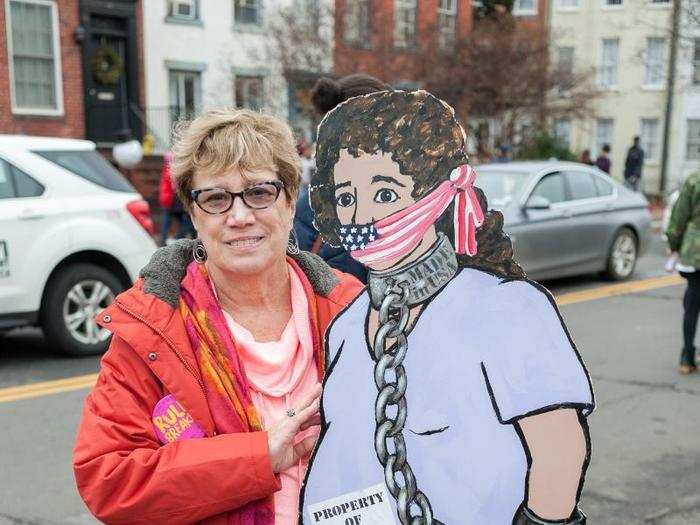
"How could I not come to this [march]? It's so important. [...] Women make up half the population. Everybody knows why it's important, but some people choose to ignore it and get what they can for themselves. If a woman doesn't have reproductive rights, a right to birth control and abortion, her life is in the hands of other people. Because she can't control her future without those two, she can't control her family. [...] It's really important for everybody to get out and be very conscious of the issues — the environmental, the social, the medical, the health issues. This isn't about whether you're a Republican or Democrat. This is about the quality of all our lives." —Deborah Neltz, an artist and sculptor from New Jersey (who's age is "nobody's business")
For many, it wasn't the first time they marched to stand up for what they believed in.
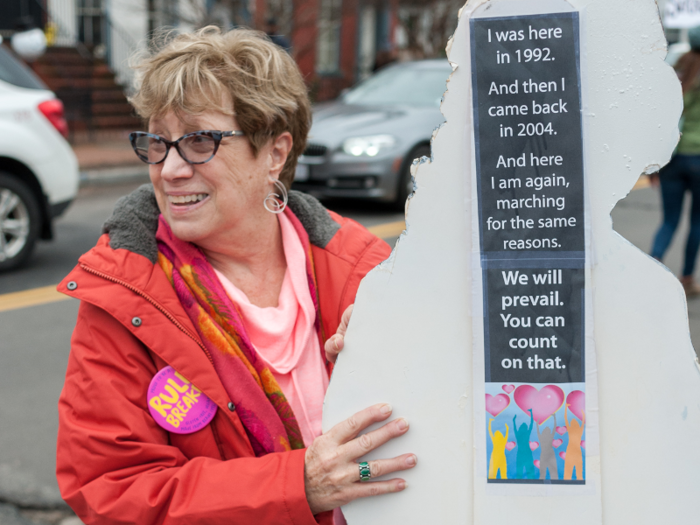
Marchers were limited to carrying clear plastic backpacks and plastic bags. Press could carry larger bags for reporting equipment, but I needed a press badge or I'd risk being stopped by security. So I inhaled a quick lunch and headed toward the press credentialing stand — and into a multitude of men, women, children, babies, signs, singing, and chanting.

One of the many chants I heard was, "Hey hey, ho ho, the patriarchy's got to go!"

The crowd quickly grew as people pushed along toward the rally stage and march starting point, at 3rd St SW and Independence Avenue.
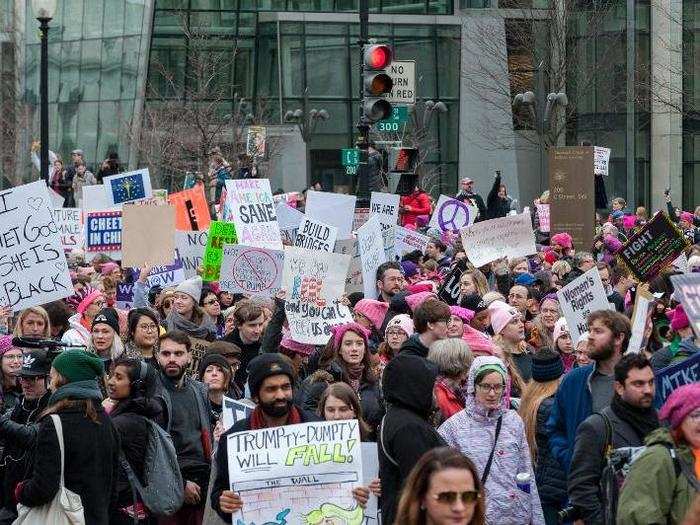
Most young kids I saw seemed to enjoy all the new sights and sounds.
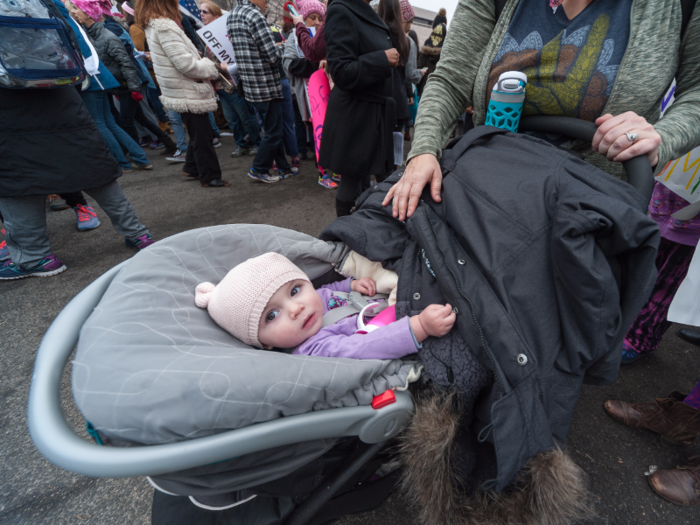
But it became very clear — very quickly — that far more than 200,000 people had showed up to the march.
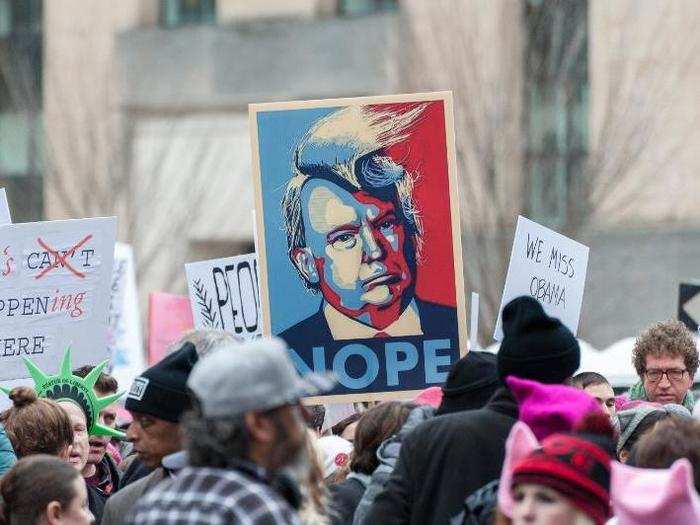
One hint: Trash cans (and their tenders) could not keep up.
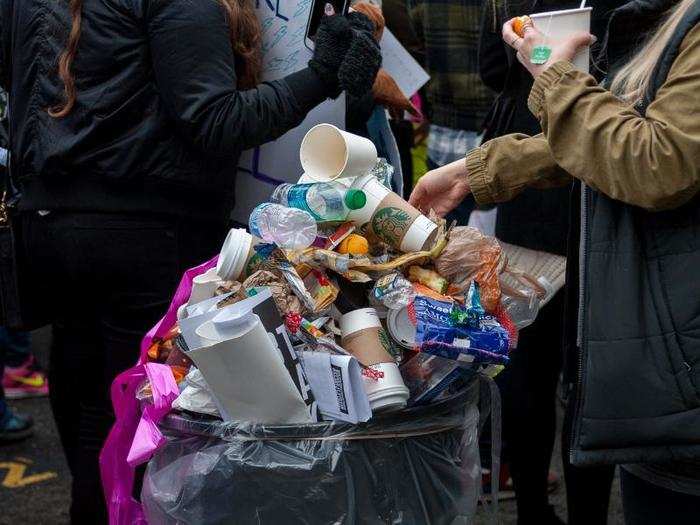
People resorted to depositing refuse in neat piles on the street.
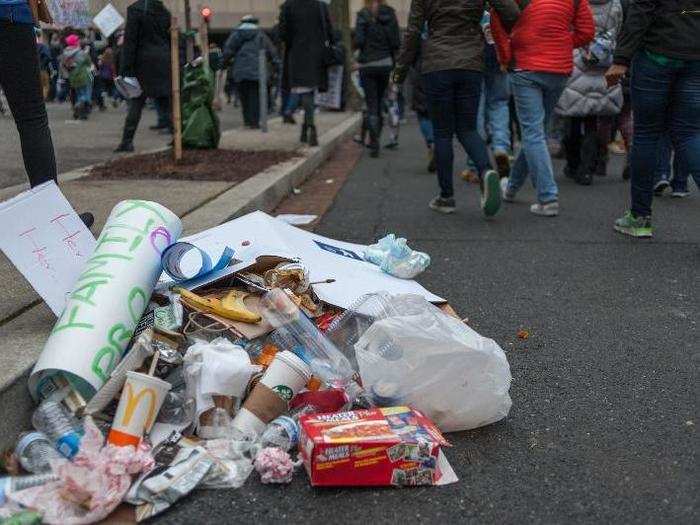
Another hint: Mobile phone data, texting, and call service was essentially dead all morning and afternoon under the crushing demand, despite the presence of portable cell towers at the National Mall. Even standing right next to one didn't seem to help.
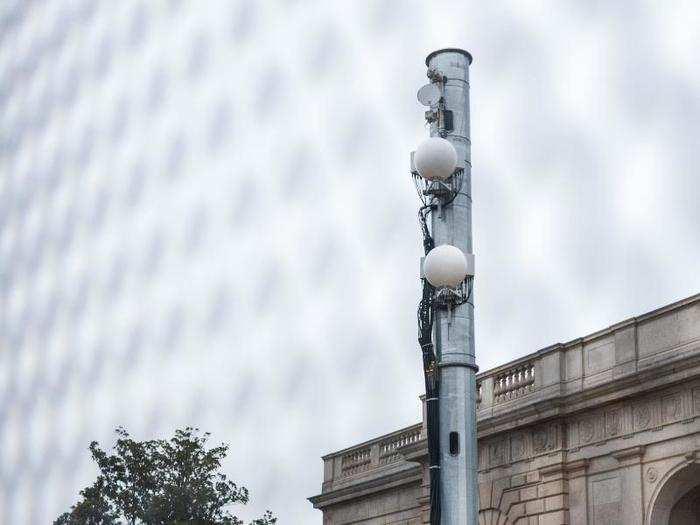
Phones were still good for taking photos, though.
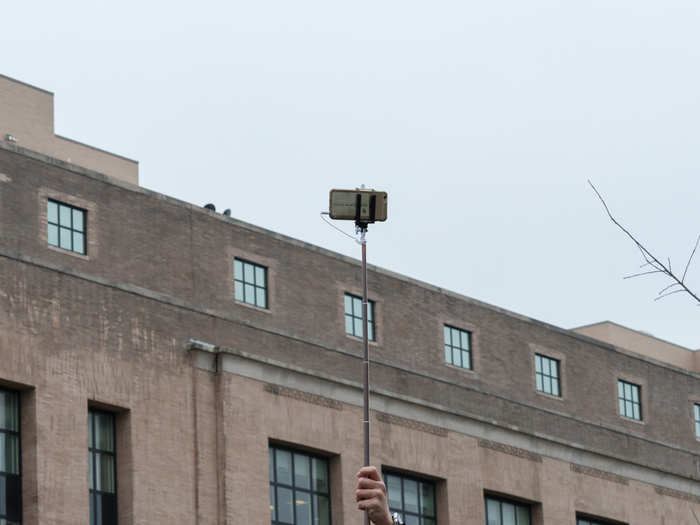
After squeezing down the street with a backpack full of camera gear, I found the press-credentialing table around 12:30 p.m. ET... Only to find they'd packed up and left. Thankfully, a fellow journalist nearby had an extra badge and gave it to me.
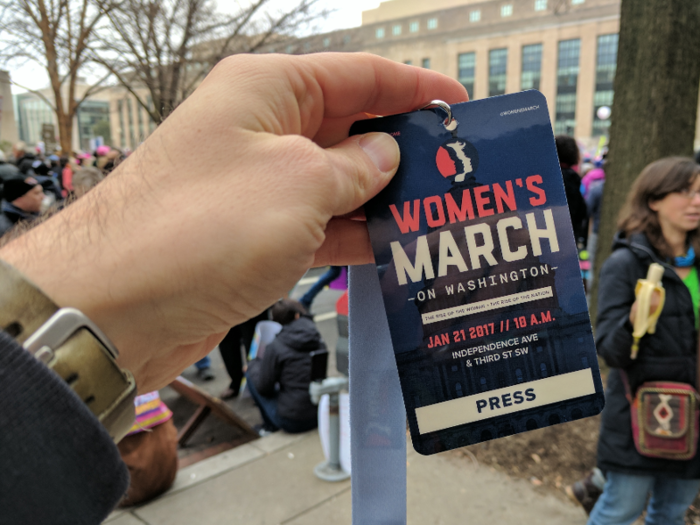
The rally stage was nearly impossible to reach due to the overwhelming turnout.
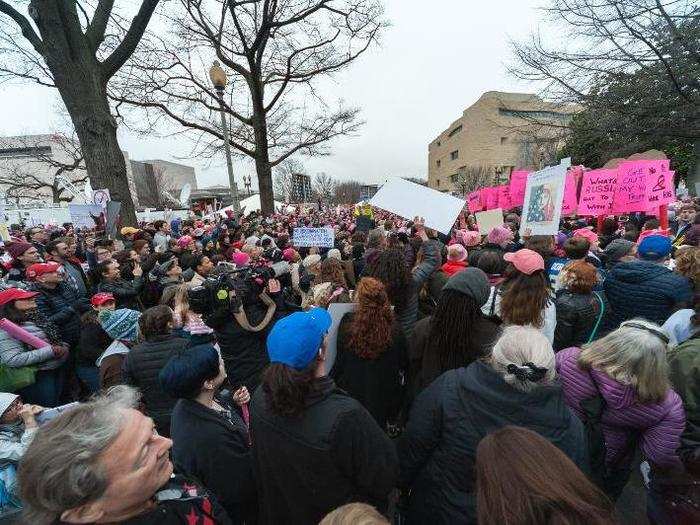
People stood on whatever they could find to get a view.
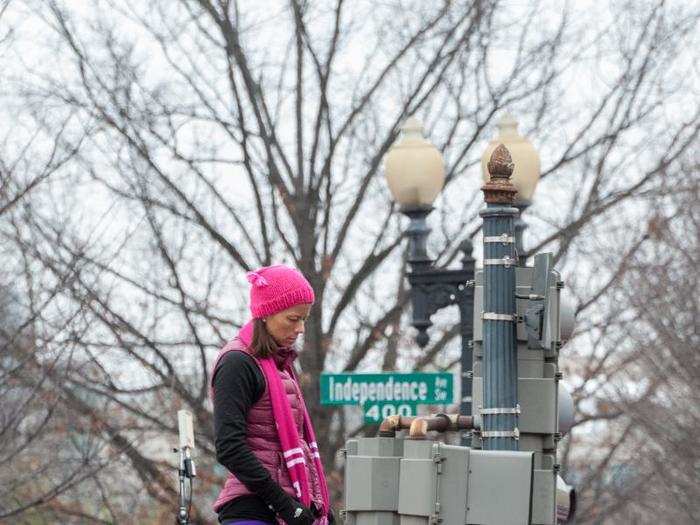
Nearly 500,000 people marched on Washington for women's rights - here's what it was like to join the crowd
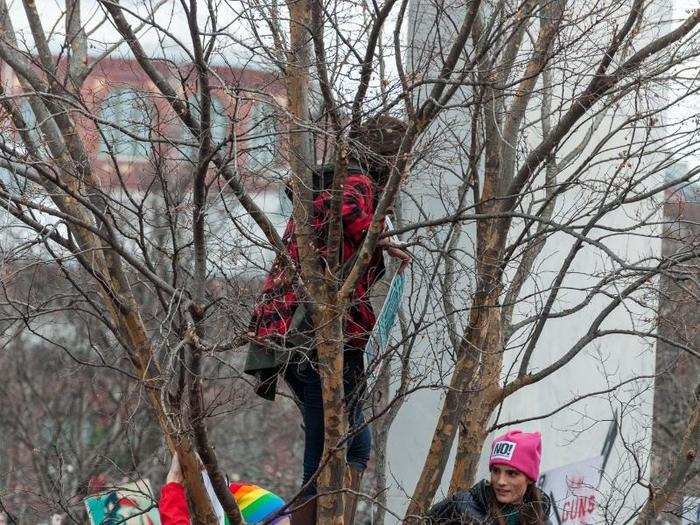
Nearly 500,000 people marched on Washington for women's rights - here's what it was like to join the crowd

Even security workers had to find creative perches.
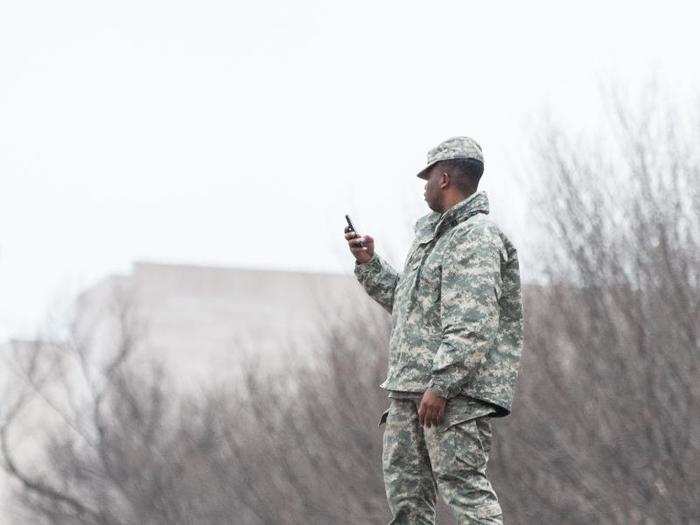
Since I couldn't easily get close to the stage, I started interviewing marchers again. Some came dressed in colorful and symbolic costumes.
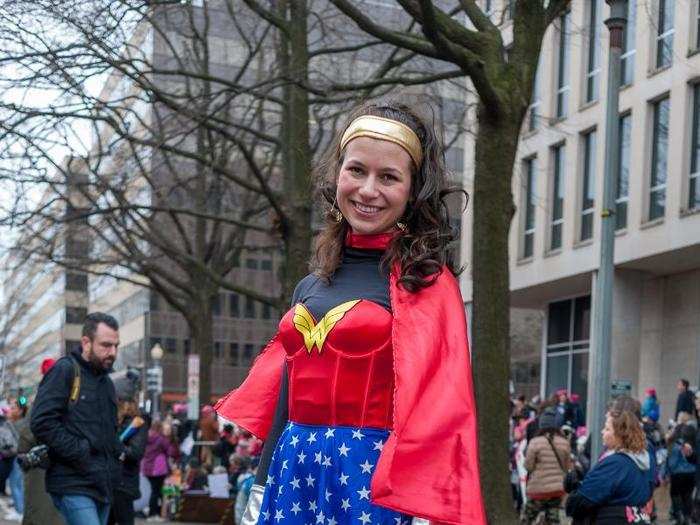
"Crowds make me a little bit anxious. So up until 6 o'clock this morning, I wasn't sure I was gonna go. But something in me just... you get over your fear. I didn't ever want to look back and think, 'I should have gone.' [...] Wonder Woman was just recognized by the [United Nations] as a symbol of female empowerment, in 2016. That's why I was Wonder Woman for Halloween, and luckily I have another reason to wear the costume. [...] There are too many reasons to name. I just feel passionate to stand up for what's right. I was with [Hillary Clinton] and everything she stood for." —Laura Claggett, from Washington DC
Most came in street clothes and warm spirits.
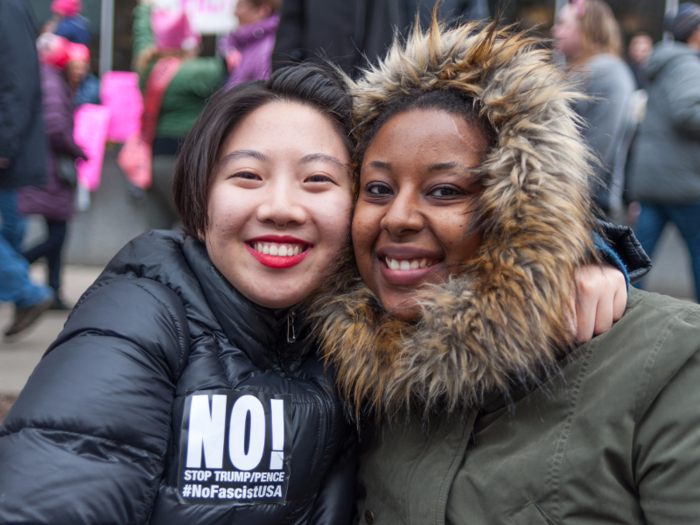
"I'm Muslim, I'm Arab, I'm from Qatar, and I just found myself to be in DC at the time of this march, so I thought it'd be a great opportunity to be a part of this. I've never been a part of a protest before, and a lot of the issues I'm here for, I can relate to. [...] At first I didn't want to be part of it because I thought it was going to be too political, so I was thinking about that. But then I realized [politics] doesn't really have to be why I'm here, but for the social issues people are speaking out against." —Yousra Khalil, a 26-year-old graduate student at George Washington University
"I'm from Seoul, South Korea, and the reason I came here today is because after Donald Trump got elected, I felt extremely invalidated — invalidated because of all the racism, sexism, and all those awful things I experienced throughout my life was now completely above the law. And that just felt like it was erasing my experience and kind of rendering me into this one stereotype. I felt like I had no face. So coming here, it was a difficult decision because I wasn't sure if I would be protected [but] I do actually [feel protected], seeing that there's so many women. [...] I think coming here is important because that's something that I'm doing for myself and everybody else that looks like me, or is like me." —Jeainny Kim (left), undergraduate student at Duke University
And some rallied their troops to show up as coordinated groups to defend their values.
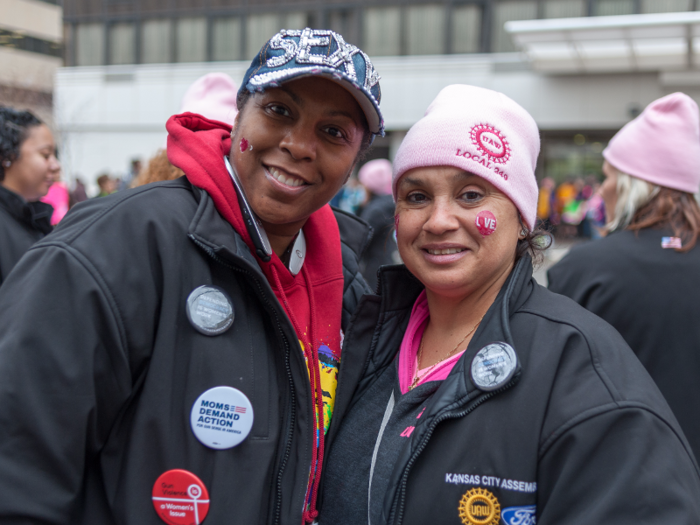
"We came from Kansas City, Kansas; Kansas City, Missouri; and St. Louis, Missouri. We represent three different unions. We are UAW women, and [the UAW is] women-strong. We are here because we're fighting for our rights. We're here because we [...] are mothers, we are grandmothers, we are sisters, we are breeders. This is what we do. If it wasn't for us, would any of you be here? No male being could be here without us." —Yolanda McLeod, a 47-year-old UAW assembly worker
"I came to this march, me personally, because I need my daughters and my granddaughters to understand that we don't have to give up our rights. We've gotta fight and make a stand [...] no matter what the cost. That's the problem now, enough of us give up our rights and just go with what the flow is. To come out here and see so many women, I know I made the right choice. [...] In my opinion, we're going backwards, not forwards. [...] We don't support right-to-work [legislation] because it gives other states the power to take away the union [and] we give up our middle class so it's either the rich or the poor." —Tina Sambol, a 49-year-old who helps build Ford F-150 trucks and is part of the United Auto Workers (UAW) Local 249 union in Kansas City, Kansas
As the start time of 1:15 p.m. ET approached, I moved west a few blocks in hopes of avoiding a scrum. Along the way, I bumped into actress Chloë Grace Moretz, who — with the help of fellow actress Jessica Chastain — politely declined my interview request.
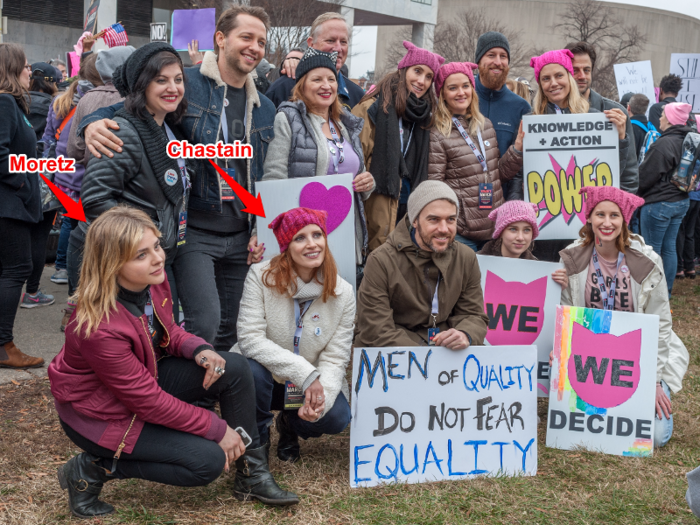
But I found willing interview subjects elsewhere.
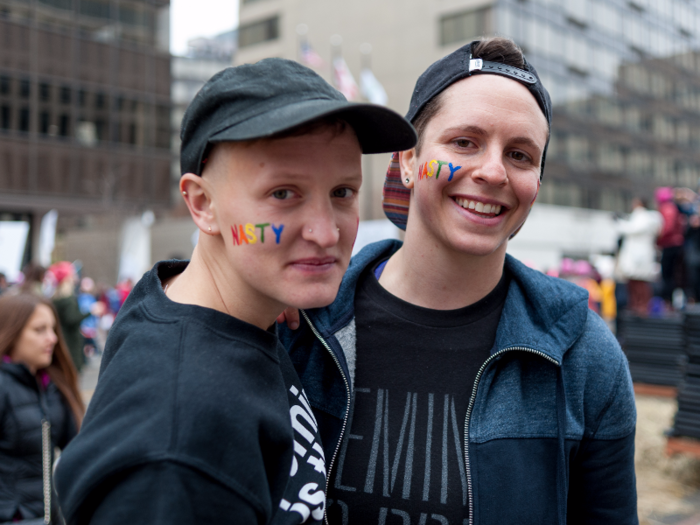
"I came for gay rights, women's rights. Gay women's rights. [...] After Trump was elected I felt like we needed to get involved and stop being complacent, to really come together as a nation. [...] I think Trump revealed some deep-seated bigotry that exists in this country, and this march, something that I think we can get out of it, is to show that we matter." —Brooke Harrison, a 26-year-old clinical psychology PhD student at the Wright Institute from Oakland, California
"You can't change what happened during the election, but we can come together as a group in solidarity and fight for women's rights, and the rights of immigrants and people of color, LGBTQ people. That's something worth fighting for. [...] Looking back in history, as far as I can remember, there hasn't been any sort of protest against a president-elect like this, and that shows something really valuable about what's going on in our country, and that we need to do something. And this march is just the first step towards greater action." —Anna Cohen-Price, a graduate student in social work at the Erikson Institute from Oakland, California
Everyone's walk in life seemed unique. I met a Native American chief who felt her people's way of life was under threat.
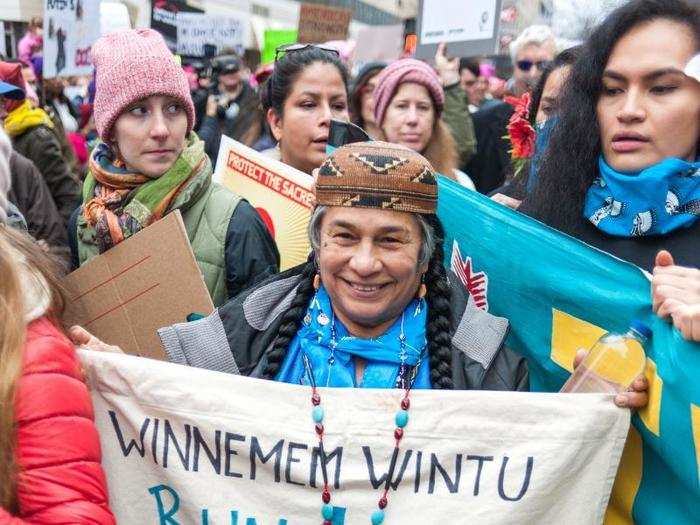
"I'm trying to help people wake up to the issues on the water, and the salmon, and the land. We are in dire straits, and the leadership that just took office... Seems like we're going to [have] real problems very shortly, just because of the Cabinet he's picking and the interests that they have is pretty much against Mother Nature, against water, against people who don't fit into the categories. The upper-middle class and above is his primary target, and people with money is who he's answering to. People without money are the masses, and this might be the only way we get to tell those folks we're still here, we matter, the Earth matters, the water matters. We've got to do something now." —Chief Caleen Sisk of the Cloud River from northern California
And a journalist who felt campaign rhetoric cut too deep for him not to march.
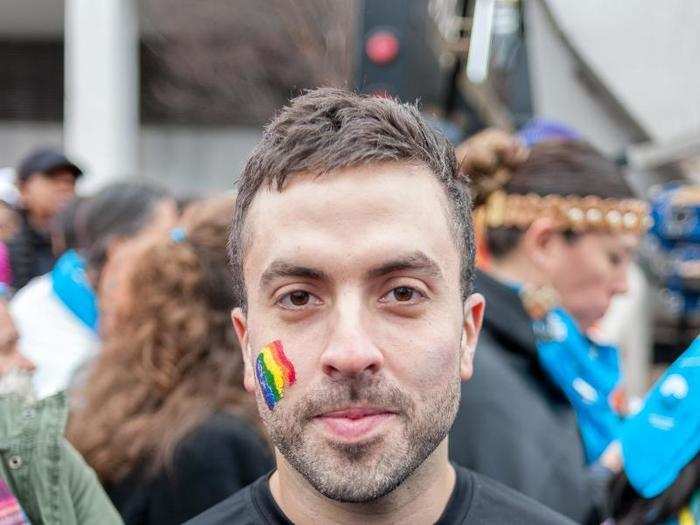
"This is where I need to be today. Because when government is against what I think it should be for, the only way for me to tell the government that is by protesting, and showing force, and sending a message. [...] I don't think this has anything to do with a political platform or opposing ideas. This is basic human rights that are on the balance." —Giddeon Grudo, a 31-year-old journalist with Air Force Magazine who lives in Washington DC
My plan to bypass the starting point by a few blocks failed: Independence Avenue and the streets around were a shoulder-to-shoulder mass of hundreds of thousands. To see it for myself, I climbed up on a dump truck filled with salt and sand.
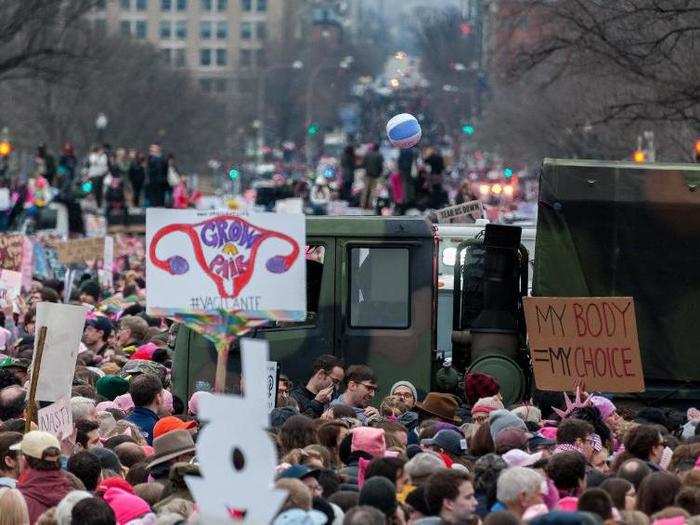
The view from the top of the truck was hard to believe. Every square inch of street and sidewalk was crammed with people.

(Click and drag to explore this 360-degree photo.)
A police officer eventually asked me and others to get down from the truck. Seeing the futility of pushing forward, I escaped the crowd behind his car and headed farther west and away from the rally stage.
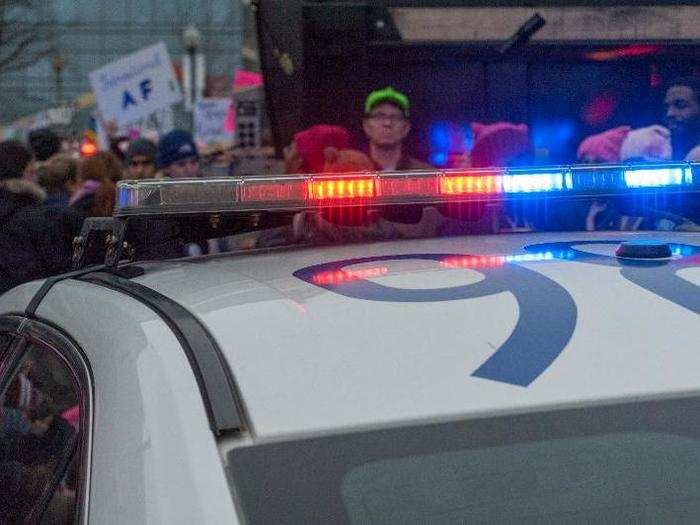
When the crowd thinned out, I met Abraham Lincoln — or rather, an actor posing as one — and his wife.
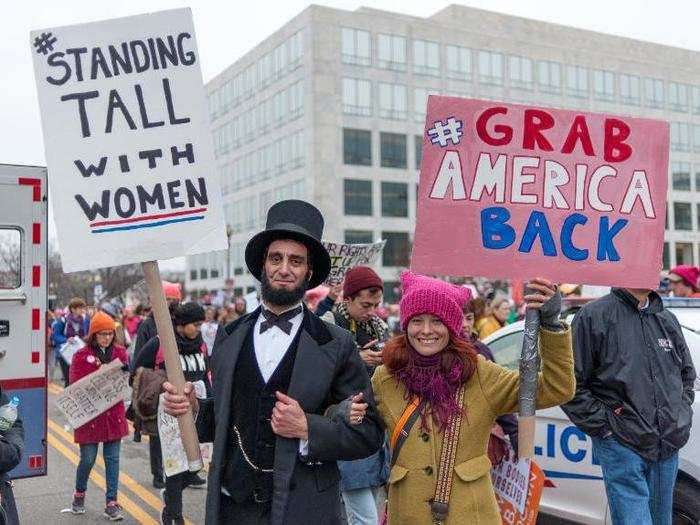
"I wanted to support my wife, and I thought, 'what better way to do that then to come as our nation's greatest president?' I am overcome by the amount of... I have never seen anything like this in my entire life. It makes me so proud to be an American. This outpouring of love, of purpose, of respect — self-respect, respect for others — and a unity of Americans that I have never before experienced. It's astonishing to me. My sign says 'standing tall with women' because I feel this administration is a danger to every woman in this country, and the men need to stand by women and support them. 'A house divided cannot stand,' as Abraham Lincoln said, and above all else, 'preserve the union.'" —Peter Straus, a 40-year-old actor in New York City
"I'm marching for women's rights, human rights. I've never been so motivated to take action, to engage the communities and to help people who are marginalized, and I feel threatened as a woman, as an LGBT woman, by Trump and his agenda. [...] We the people, we are America, and I'm here with Abraham Lincoln, one of my heroes." —Stephanie Sellars, a 40-year-old filmmaker and writer in New York City
It was 3 p.m. ET by the time I made it onto Independence Avenue, but the "march" still wasn't marching. While I tried to figure out what to do, Madonna spoke a few passionate, curse-laden words while parents covered their kids' ears, eventually breaking into song with "Express Yourself."

It was around that time I decided to find my family — and a restroom that wasn't filled to the brim — and head back to Arlington.
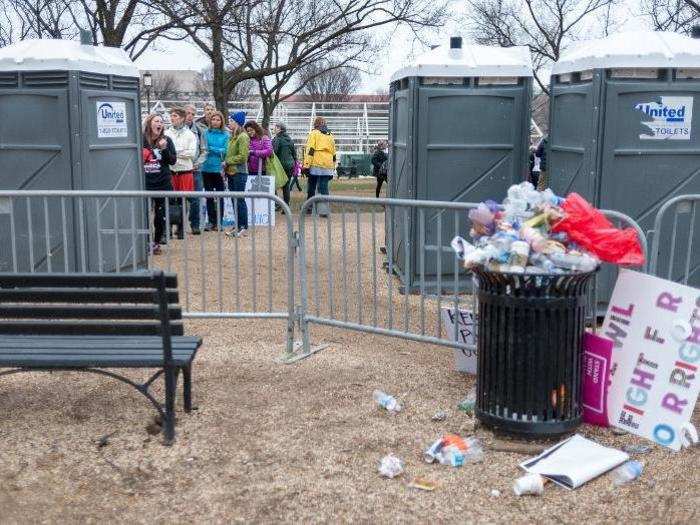
Around 3:30 p.m. ET, I found my clan. And — more than 2 hours behind schedule — the march finally seemed to be moving toward its final destination: the White House.

But with a baby who hadn't napped all day, it was time to head home. We snaked through the IRS courtyard to get to a Metro station far away from the crowd.
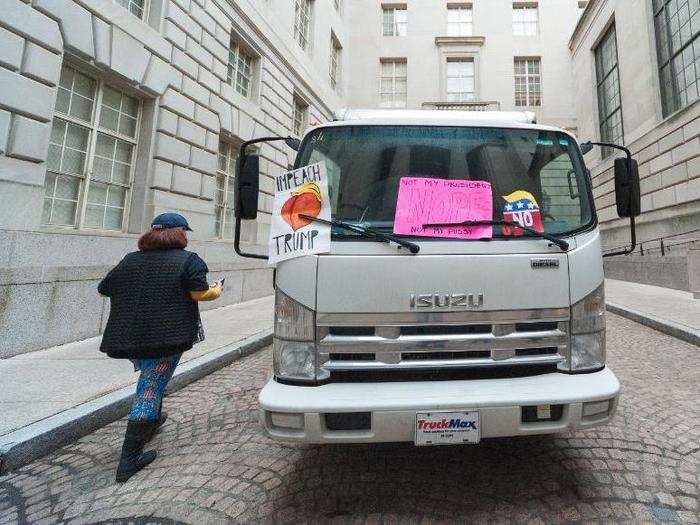
But it didn't really help, and Uber and Lyft's network was overloaded. So we hopped into a very long line for the Metro ...
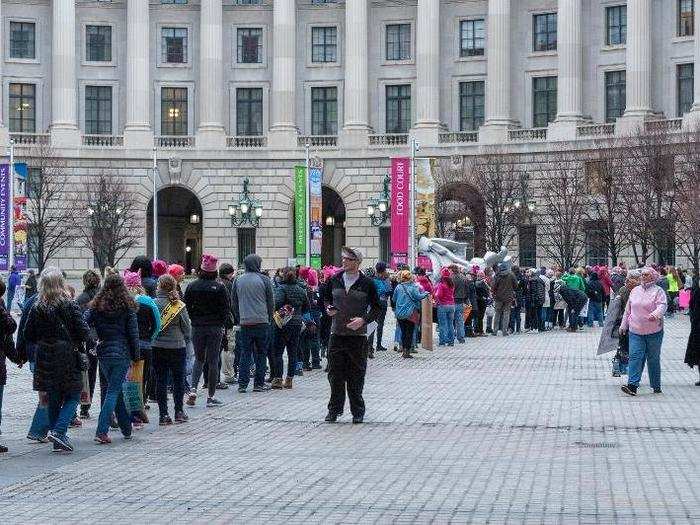
... that stretched all the way underground ...
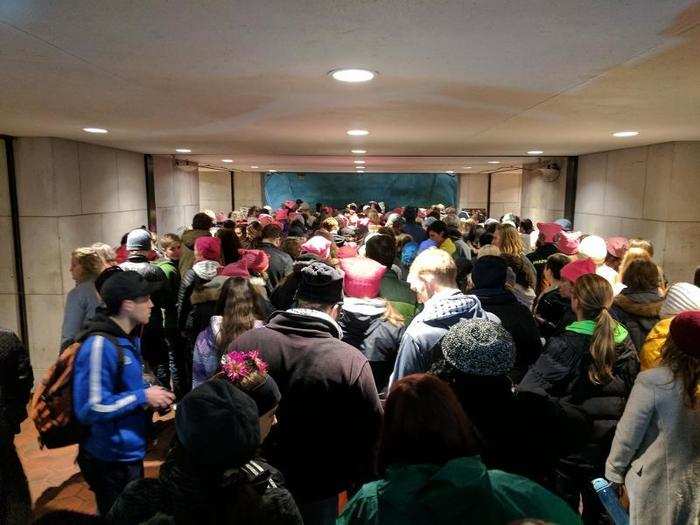
... and poured into a dense crowd that pushed toward the edge of the platform.

It "only" took an hour and a half to make the normally 25-minute trip back, but eventually we were free.
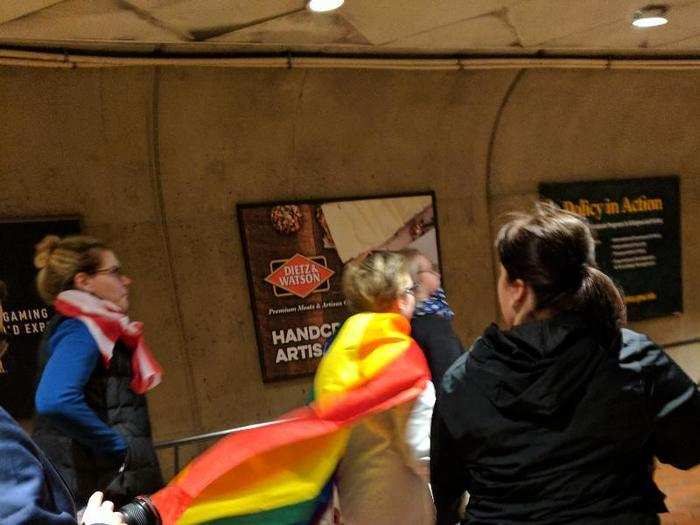
Although my wife and relatives were disappointed the march morphed into more of a giant stationary rally (our babies like to keep moving), they had no doubts about the event's significance, their place in it, and the courage it had instilled within them.
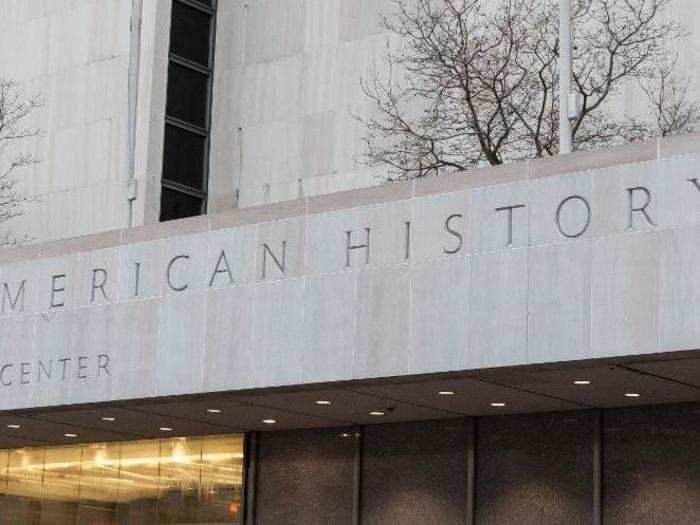
Popular Right Now
Advertisement